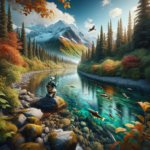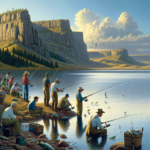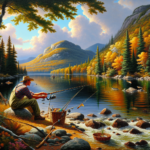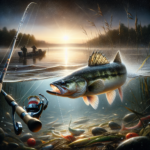Fishing in Alaska: Best Locations and Seasonal Tips

Introduction
Did you know that Alaska is home to over 3 million lakes and 12,000 rivers, making it one of the premier fishing destinations in the world? Whether you’re an experienced angler or a novice looking to cast your first line, Alaska offers unparalleled opportunities for fishing enthusiasts. This article will guide you through the best fishing locations in Alaska, provide seasonal tips, and offer practical advice to make your fishing trip a success.
We will cover the top fishing spots, the best techniques to use, the species you can expect to catch, and essential gear recommendations. Additionally, we’ll discuss seasonal variations, local regulations, and safety tips to ensure a responsible and enjoyable fishing experience.
Understanding the best locations and seasonal tips for fishing in Alaska is crucial for maximizing your success and enjoyment. Whether you’re targeting salmon, trout, or halibut, knowing where and when to fish can make all the difference.
Background/Context
Historical or Cultural Significance
Fishing has been an integral part of Alaskan culture for thousands of years. Indigenous communities have relied on the abundant fish populations for sustenance and trade. Today, fishing remains a vital part of Alaska’s economy and lifestyle, attracting anglers from around the globe.
Geographical Overview
Alaska’s diverse geography includes vast coastlines, numerous rivers, and countless lakes. The state’s climate varies significantly from the temperate rainforests of the southeast to the arctic tundra in the north. This diversity creates a wide range of fishing environments, each with its unique challenges and rewards.
Key Points/Details
Fishing Techniques
Technique Overview
Alaska offers a variety of fishing techniques, including fly fishing, spin fishing, and trolling. Fly fishing is particularly popular for targeting salmon and trout in rivers and streams. Spin fishing is versatile and can be used in both freshwater and saltwater environments. Trolling is commonly used in saltwater to catch larger species like halibut and king salmon.
When and Where to Use
Fly fishing is best used in rivers and streams during the salmon runs, typically from June to September. Spin fishing can be effective year-round but is particularly productive during the summer months. Trolling is most successful in coastal waters from May to September.
Recommended Gear
- Fly Fishing: 9-foot rod, 8-10 weight line, and a variety of flies.
- Spin Fishing: Medium to heavy rod, 10-20 lb test line, and a selection of lures and bait.
- Trolling: Heavy-duty rod, 30-50 lb test line, downriggers, and large lures or bait.
Species Information
Species Overview
Alaska is home to a wide variety of fish species, including five types of Pacific salmon (king, sockeye, coho, pink, and chum), rainbow trout, Dolly Varden, Arctic char, and halibut. Each species has its unique habits and preferred habitats.
Best Practices
For salmon, timing is crucial. The best time to catch king salmon is from May to July, while sockeye and coho are most abundant from June to September. Rainbow trout and Dolly Varden can be caught year-round but are most active in the summer. Halibut fishing is best from May to September.
Location Information
Top Fishing Spots
- Bristol Bay: Known for its incredible salmon runs, particularly sockeye salmon.
- Kenai River: Famous for its king salmon and rainbow trout.
- Kodiak Island: Offers excellent opportunities for halibut and salmon fishing.
- Sitka: A prime location for saltwater fishing, including king salmon and halibut.
- Prince William Sound: Known for its diverse fish populations, including salmon, halibut, and rockfish.
Regulations and Licenses
Fishing in Alaska requires a valid fishing license, which can be purchased online or at local retailers. Specific regulations vary by region and species, so it’s essential to check the Alaska Department of Fish and Game website for the latest information on catch limits, seasonal restrictions, and protected areas.
Seasonal Considerations
Seasonal Variations
Fishing conditions in Alaska change dramatically with the seasons. Summer offers the best weather and the most abundant fish populations, while winter can be challenging due to ice and cold temperatures. Spring and fall provide unique opportunities for targeting specific species like steelhead and late-season salmon.
Best Times to Fish
The optimal times to fish in Alaska are from May to September, with peak activity in June and July. Early mornings and late evenings are generally the best times of day to fish, as many species are more active during these cooler periods.
Events and Tournaments
Event Overview
Alaska hosts several fishing events and tournaments throughout the year, including the Homer Jackpot Halibut Derby, the Seward Silver Salmon Derby, and the Kenai River Classic. These events offer opportunities for anglers to compete for prizes and enjoy the camaraderie of fellow fishing enthusiasts.
Preparation Tips
To prepare for a fishing event or tournament, ensure you have the appropriate gear, practice your techniques, and familiarize yourself with the event rules and regulations. Arrive early to secure a good spot and consider hiring a local guide for insider tips and strategies.
Tips and Best Practices
General Tips
- Always check the weather forecast before heading out.
- Use local knowledge to find the best fishing spots.
- Practice catch and release to help preserve fish populations.
Avoid Common Mistakes
- Not checking local regulations: Always ensure you are aware of the latest rules and restrictions.
- Using the wrong gear: Match your equipment to the species and conditions.
- Ignoring safety precautions: Always wear a life jacket and be aware of your surroundings.
Advanced Techniques
- Mastering the double haul cast for fly fishing can increase your casting distance and accuracy.
- Using electronics like fish finders can help locate fish more efficiently.
- Experimenting with different lures and baits can improve your success rate.
Gear and Equipment Recommendations
Essential Gear
- Fishing rod and reel appropriate for your chosen technique.
- High-quality fishing line and a variety of lures or bait.
- Waders and waterproof clothing for river and stream fishing.
- Life jacket and safety equipment for boating.
Optional Gear/Upgrades
- Fish finder or sonar for locating fish.
- Downriggers for trolling in deep water.
- Polarized sunglasses to reduce glare and see fish more clearly.
Where to Buy or Rent
Local shops in major fishing areas like Anchorage, Juneau, and Fairbanks offer a wide range of gear for purchase or rent. Online retailers like Cabela’s and Bass Pro Shops also provide extensive selections of fishing equipment.
Safety and Conservation
Safety Tips
- Always wear a life jacket when boating.
- Be aware of wildlife, including bears and moose, and know how to react if you encounter them.
- Check weather conditions and be prepared for sudden changes.
Conservation Practices
- Practice catch and release to help maintain fish populations.
- Respect local wildlife and their habitats.
- Follow all fishing regulations and guidelines.
Planning Your Trip
Accommodations
Alaska offers a range of accommodations, from rustic cabins and lodges to modern hotels. Popular fishing destinations like the Kenai Peninsula and Kodiak Island have numerous options to suit different budgets and preferences.
Travel Tips
Most fishing spots in Alaska are accessible by car, but some remote locations may require a bush plane or boat. Plan your route in advance and consider renting a vehicle with four-wheel drive for off-road access.
Additional Activities
In addition to fishing, Alaska offers a wealth of outdoor activities, including hiking, wildlife viewing, and kayaking. Many fishing lodges also offer guided tours and excursions to enhance your trip.
Frequently Asked Questions (FAQs)
Do I need a fishing license in Alaska?
Yes, a valid fishing license is required for all anglers in Alaska. Licenses can be purchased online or at local retailers.
What is the best time of year to fish in Alaska?
The best time to fish in Alaska is from May to September, with peak activity in June and July.
What species of fish can I catch in Alaska?
Alaska is home to a variety of fish species, including five types of Pacific salmon, rainbow trout, Dolly Varden, Arctic char, and halibut.
Are there any fishing regulations I need to be aware of?
Yes, fishing regulations vary by region and species. Check the Alaska Department of Fish and Game website for the latest information on catch limits, seasonal restrictions, and protected areas.
Conclusion
Fishing in Alaska offers an unparalleled experience for anglers of all skill levels. By understanding the best locations, techniques, and seasonal tips, you can maximize your success and enjoyment. Remember to follow local regulations, practice conservation, and prioritize safety to ensure a responsible and rewarding fishing adventure.
Whether you’re targeting salmon in the Kenai River or halibut off the coast of Kodiak Island, Alaska’s diverse fishing opportunities are sure to provide an unforgettable experience. So pack your gear, plan your trip, and get ready to explore the incredible fishing that Alaska has to offer.




